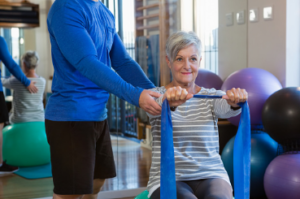What Is Exercise Physiology?
Exercise physiology is the scientific study of how the body responds to short- and long-term exercise. As a growing medical and fitness field, exercising can offer you an exciting career choice.
 Exercise physiologists research the physiological effects of physical activity on humans and use that understanding to assist those with health conditions, injuries or athletic performance. Additionally, they consult with amateur and professional athletes looking to enhance their fitness levels and endurance levels.
Exercise physiologists research the physiological effects of physical activity on humans and use that understanding to assist those with health conditions, injuries or athletic performance. Additionally, they consult with amateur and professional athletes looking to enhance their fitness levels and endurance levels.
Cardiorespiratory System
The cardiovascular system (also referred to as the heart and lungs) helps oxygenate our blood and eliminate carbon dioxide or waste. It consists of two pulmonary and systemic circuits; these work together to deliver and remove oxygen from within our bodies.
Exercise is essential for the heart’s proper function; it needs to pump out large volumes of blood quickly. In addition, cardiorespiratory endurance improves exercise capacity and allows you to exert yourself longer without fatigue.
Oxygen is essential for all body tissues, muscles and organs to function optimally. The Cardiorespiratory System transports oxygen from your lungs into your bloodstream, distributing it evenly throughout all body cells. Conversely, it picks up carbon dioxide from the bloodstream and returns it to the lungs for exhalation.
Exercise causes your breathing rate to increase from its resting level of 12-16 breaths per minute up to 40 or more. This is because, during exercise, your heart pumps more blood through the lungs than usual. Learn more about exercise physiology Woodville.
The lungs contain alveoli, one-cell thick membranes that allow air and oxygen molecules to pass between them and the body’s blood vessels. Furthermore, capillaries exist within these lungs – tiny blood vessels that transport oxygen from the alveoli to tissues in the body while returning waste products to the lungs.
Musculoskeletal System
The musculoskeletal system comprises your body’s bones, tendons, ligaments and muscles. It supports body weight, helps with posture and moves you around. But, unfortunately, it can become damaged due to aging, injuries or disease. Still, you can keep this part of your health by eating nutritiously, exercising regularly and visiting a healthcare provider for check-ups regularly.
The brain sends messages to your skeletal muscles to contract (tend). When the muscle activates or bunches up, nerves send another signal to a tendon attached to a bone which pulls on that joint, causing it to move. When the muscle relaxes, tension is released on the bone, and it returns to its resting position.
Studies have demonstrated that exercise can benefit people with various diseases and conditions. It increases strength and endurance in specific muscles, assists in healing from injuries, and strengthens overall body strength.
Neuromuscular System
The neuromuscular system is an intricate and essential organ of the human body, controlling every movement and even breathing for you.
Motor neuron cells in the brain and spinal cord send messages to muscle cells that contract as instructed.
Neuronal signals from the nerves travel through nerves to skeletal muscle at synapses, where they trigger chemical releases that cause muscle contraction. Each synapse consists of an axon terminal, presynaptic cell, and synaptic cleft that connects it with its target post-synaptic cell.
Age-related changes to the neuromuscular system can impact several aspects of daily living and physical activity. These modifications include decreased joint proprioception, diminished strength and power, and impaired balance control.
These exercise physiology Woodville findings are critical for anyone involved in athletic pursuits. They illustrate the necessity to comprehend how exercise can influence changes to the neuromuscular system and how best to use them for training. As research progresses, more efficient methods will likely be discovered to enhance exercise physiology and the health of our athletes.
Biomechanics
Biomechanics is a field of study that applies the principles of mechanics to analyse how the body moves. It has many applications and uses, such as designing equipment for sports, diagnosing individual movements to enhance performance and making recommendations on training protocols, treating injuries and informing injury prevention strategies.
Biomechanical analysis can assist athletes of all ages and skill levels refine their technique to reduce the risk of injury. It also helps coaches and teachers understand the most effective ways to teach students or athletes new skills.
Biomechanics in exercise physiology is often employed to enhance athletic performance. It can be accomplished through changes to equipment design, more efficient techniques or altering specific training protocols used by coaches and trainers to help athletes reach their objectives.
